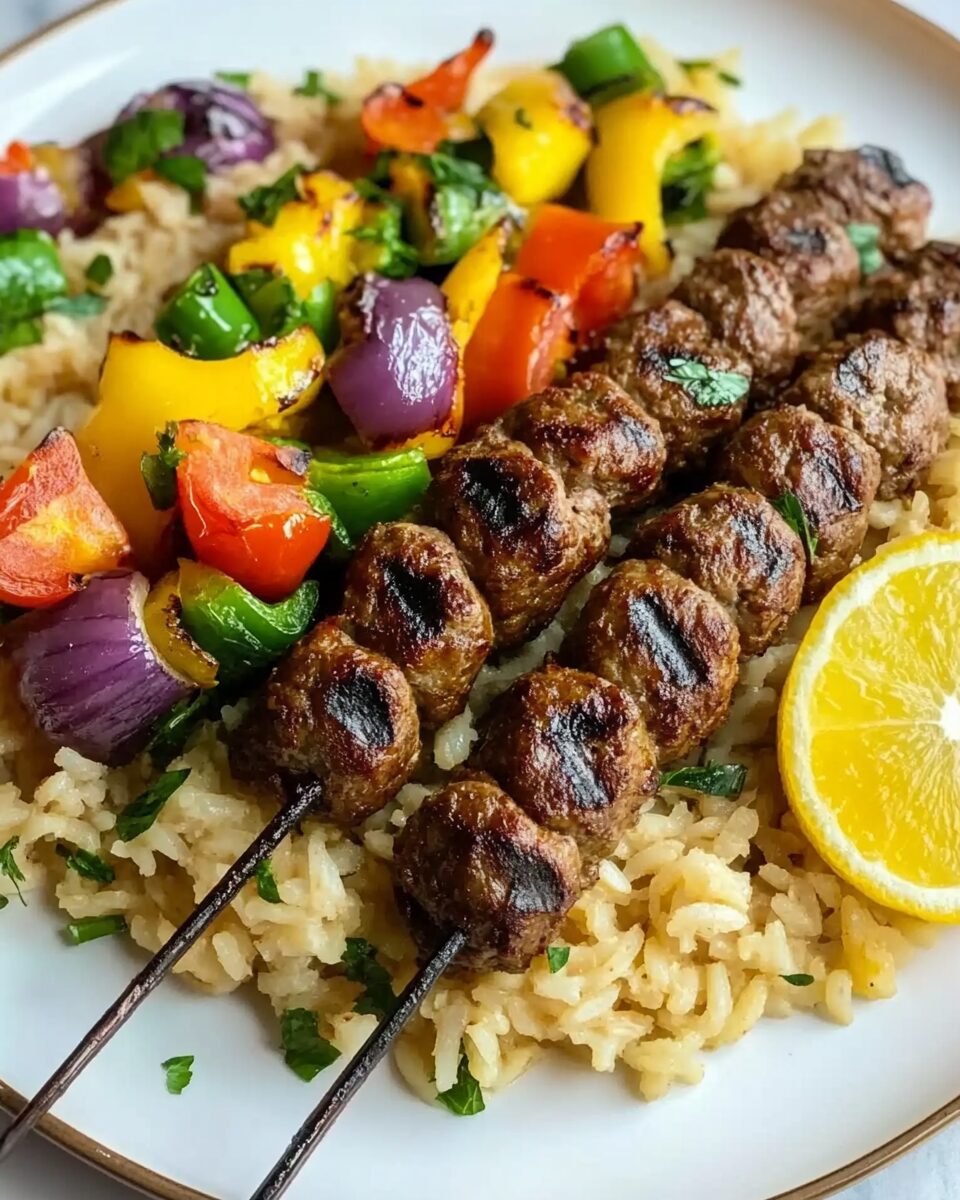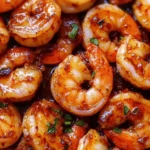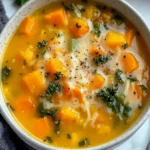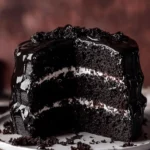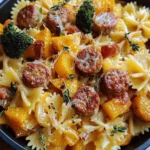These Beef Kafta Kabobs bring the vibrant flavors of the Mediterranean to your table. Each skewer is infused with fragrant spices, creating a tender and juicy kebab that’s perfect for any occasion.
Serve these delicious kafta kebabs with a side of hummus, tzatziki, or a fresh cucumber salad for an authentic dining experience. Whether you’re hosting a backyard barbecue or preparing a quick family dinner, these kabobs are sure to be a hit with their irresistible taste and simplicity.
Full Recipe:
Ingredients:
- 1 lb ground beef
- 1 small onion, finely grated
- 2 cloves garlic, minced
- 1/4 cup fresh parsley, finely chopped
- 2 tsp ground cumin
- 1 tsp ground coriander
- 1/2 tsp smoked paprika
- 1/2 tsp ground cinnamon
- 1/4 tsp cayenne pepper (optional)
- Salt and black pepper to taste
- Wooden or metal skewers
Directions:
- In a large mixing bowl, combine the ground beef, onion, garlic, parsley, cumin, coriander, smoked paprika, cinnamon, cayenne pepper, salt, and black pepper. Mix until evenly blended.
- Divide the mixture into equal portions and shape each portion into a long, thin sausage shape around the skewers.
- Preheat your grill or grill pan to medium-high heat. Lightly oil the grates to prevent sticking.
- Grill the kafta kebabs for 4-5 minutes per side, or until cooked through and slightly charred on the outside.
- Serve hot with your favorite sides such as flatbread, rice, or a fresh salad.
Prep Time: 15 minutes | Cooking Time: 10 minutes | Total Time: 25 minutes
Kcal: 220 kcal per serving | Servings: 4
Origin and Cultural Significance
Beef Kafta Kabobs are a beloved dish in Middle Eastern and Mediterranean cuisines, known for their aromatic blend of spices and fresh herbs. This dish has origins in Levantine cooking, where ground meat is mixed with onions, garlic, parsley, and a variety of spices to create flavorful skewers that are grilled to perfection. Kafta (or Kofta) translates to “meatball” in many languages across the region, and variations of this dish can be found in Lebanese, Turkish, and Persian kitchens, each adding its unique twist to the recipe.
Traditionally, Kafta is served with accompaniments like warm pita bread, tahini sauce, or a refreshing cucumber-yogurt salad. It’s a staple at family gatherings, festive occasions, and outdoor barbecues, embodying the spirit of communal dining.
Customization Tips
One of the great aspects of this recipe is its adaptability. Here are some ideas to make the dish suit different tastes and dietary needs:
- Protein Options: Substitute ground beef with lamb, chicken, or even plant-based meat alternatives for a vegetarian version. The flavors of the spices will complement any protein choice.
- Herbs and Spices: Experiment with additional herbs like cilantro or mint for a unique flavor profile. You can also adjust the level of cayenne pepper to control the heat.
- Cooking Method: If you don’t have a grill, these kebabs can be cooked on a stovetop grill pan or even baked in the oven. For a smoky flavor, consider adding a pinch of smoked salt.
- Shape and Presentation: For smaller bites, shape the mixture into mini patties or meatballs instead of skewers. These make great appetizers for parties.
Serving Suggestions
- Pair these Kafta Kabobs with a Mediterranean rice pilaf, roasted vegetables, or a vibrant tabbouleh salad for a complete meal.
- Serve with dipping sauces like garlic toum, hummus, or tzatziki for added creaminess.
- Offer warm pita bread or flatbread to scoop up the kebabs and sauces, creating a wrap-style meal.
Cooking Tips for Perfect Kafta
- Grate the Onion: Finely grating the onion ensures it blends seamlessly into the meat mixture, enhancing the flavor and keeping the kebabs juicy.
- Chill Before Grilling: After shaping the kafta onto skewers, refrigerate them for 30 minutes. This helps the mixture firm up and stay intact while cooking.
- Avoid Overmixing: Mix the ingredients just until combined. Overmixing can result in dense kebabs.
- Use Wet Hands: Wetting your hands before shaping the kafta helps prevent the mixture from sticking.
Nutritional Benefits
Beef Kafta Kabobs are not only delicious but also offer a nutritious meal option. They are high in protein and iron, thanks to the lean ground beef. The addition of parsley and onions provides a boost of vitamins and antioxidants, while the use of spices like cumin and paprika adds anti-inflammatory properties.
Fun Fact
In some regions, kafta is cooked without skewers and shaped into long patties that are pan-fried or oven-baked. This method is often used for quick meals, especially when grilling isn’t an option.
History and Culinary Heritage
Beef Kafta Kabobs trace their roots to the Middle East, where the combination of minced meat, spices, and herbs has been perfected over centuries. The dish is thought to have originated in the Levant region, encompassing countries like Lebanon, Syria, and Jordan. Kafta, known by various names such as kofta or kufta, is a term derived from the Persian word “kūfteh,” meaning “to grind” or “pound.” This highlights the traditional preparation method of finely mincing meat for a tender and flavorful result.
Kafta is a common street food and a staple at family meals, reflecting the rich traditions of Middle Eastern hospitality. The recipe’s simplicity and adaptability have made it a favorite across cultures, often served at celebrations, barbecues, or cozy family dinners.
Why This Recipe Stands Out
- Flavorful Ingredients: The blend of spices such as cumin, coriander, and paprika, combined with fresh parsley and onion, creates a vibrant and aromatic flavor profile.
- Quick and Easy: With minimal prep time and straightforward instructions, this recipe is perfect for busy weeknights or when you want to impress guests without spending hours in the kitchen.
- Healthy Option: Lean ground beef and the absence of heavy sauces make these kebabs a lighter yet satisfying meal choice.
Variations Across Cultures
While the recipe focuses on the Middle Eastern version, similar dishes are found worldwide, each with its own twist:
- Indian Kofta: Often made with ground lamb or chicken, mixed with spices and sometimes stuffed with boiled eggs or dried fruits.
- Greek Souvlaki: Though not kafta, Greek skewers are similar in preparation and flavor when paired with tzatziki and pita.
- Turkish Köfte: These are typically pan-fried and served with yogurt sauce or over rice pilaf.
Pairing and Serving Suggestions
Accompaniments:
- Serve alongside a refreshing cucumber-tomato salad dressed with olive oil and lemon juice.
- Pair with a creamy tahini sauce or spiced yogurt dip for added richness.
- Add a carb option like garlic naan, pita bread, or a bowl of jeweled rice (rice with nuts and dried fruits) for a complete meal.
Beverage Pairing:
- A light and citrusy white wine such as Sauvignon Blanc complements the spices beautifully.
- For non-alcoholic options, try a chilled mint lemonade or sparkling water with a splash of pomegranate juice.
Tips for the Best Kafta
- High-Quality Meat: Use freshly ground beef with a good balance of lean meat and fat for juicy and flavorful kebabs.
- Uniform Sizing: Shape the kafta evenly to ensure consistent cooking.
- Keep it Cool: Keeping the meat mixture chilled before shaping helps the kafta hold its shape on the skewers.
- Pre-soak Wooden Skewers: If using wooden skewers, soak them in water for at least 30 minutes to prevent burning.
Creative Presentation Ideas
- Family-Style Platter: Arrange the skewers on a large platter with grilled vegetables, fresh herbs, and a drizzle of tahini sauce for a beautiful table centerpiece.
- Individual Plates: Serve each person a skewer with a small portion of salad, a dollop of yogurt sauce, and a wedge of lemon for a neat and elegant presentation.
- Wraps: Offer warm pita bread and let diners create their own wraps with kafta, veggies, and sauces.
Interesting Facts About Kafta
- Kafta is often considered a comfort food in Middle Eastern households and is passed down through generations with slight variations in spices or preparation.
- It’s one of the oldest recorded recipes for minced meat, with historical references found in ancient cookbooks from the region.
- Kafta isn’t limited to grilling—it can also be baked, fried, or cooked in tomato-based stews for a different taste experience.
Conclusion
Beef Kafta Kabobs are a flavorful and versatile dish, perfect for any occasion. With their aromatic spices and juicy texture, they bring the rich traditions of Middle Eastern cuisine to your table. Serve them with fresh salads, creamy dips, or hearty grains, and customize the recipe to suit your taste. Easy to prepare and bursting with flavor, these kabobs are sure to become a favorite in your meal rotation!

